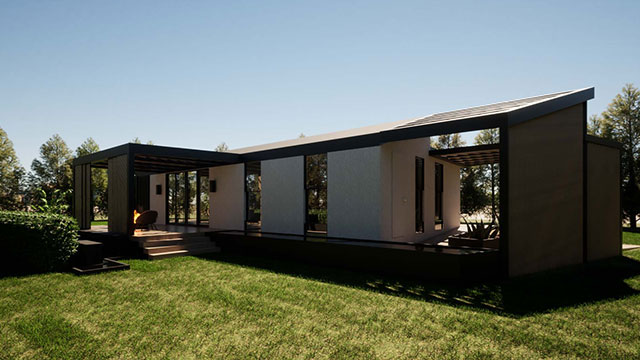Cal Poly Pomona has formed a multidisciplinary team of students, faculty, industry mentors and sponsors to design and build a beautiful energy- and water-efficient, market-ready family home for the inaugural Orange County Sustainability Decathlon (OCSD).
The Cal Poly Pomona Roots House is competing against 10 structures built by teams from far away as China. The houses will be on display and open for public tours at the Orange County Fair and Event Center in Costa Mesa on Oct. 5-8 and Oct. 12-15.
OCSD is a new state-funded international juried competition that challenges collegiate teams to design and build solar-powered homes - a real-world exercise themed around two of California's intersecting policy priorities: climate change and affordable housing.
Roots House was designed with a vision of the Roots Community, a multigenerational neighborhood of young families and seniors living alongside and supporting each other. The affordable, sunlit, two-bedroom, one-bath home measures 1,008 square feet. Its first full assembly and completion took place at the Orange County Fair and Event Center.
The team's faculty leader, Civil Engineering Assistant Professor Sunai Kim, envisions two options for the future: (1) bringing the Roots House to market in five to 10 years for use as an accessory dwelling unit (ADU), also known as a backyard cottage or granny flat; and (2) developing the Roots Community to foster climate-resilient multigenerational neighborhoods. The Roots House's notable features include:
- Energy Efficiency: Passive cooling and natural ventilation, natural lighting with clerestory windows, white cool roof with a high Solar Reflectance Index to keep the house naturally cool, ENERGYSTAR appliances, mini split system to reduce energy costs, high-performance solar panels and battery, and a fast-charging EV Charger.
- Water Efficiency: Greywater system (recycles water from shower, bath sink and clothes washer for toilet flushing and irrigation), rain barrels, low-flow water conservation fixtures, and a fog collection - a key engineering feature for water conservation.
- Materials: Chosen for their low embodied energy and chosen per Life Cycle Analysis, with consideration for low maintenance and durability. Chemical-free materials (Living Building Challenge's Red List) were selected for the flooring and countertops.
The design model and final structure are the culmination of three semesters' work by 100 students across nine majors (civil, chemical, environmental, mechanical, electrical and computer engineering; architecture; regenerative studies; and business administration).
A large part of the funds to build and the sustainable construction materials were received through in-kind donations by nearly 50 sponsors, including Chino-based AMCO Structures for construction. The plan is to sell the first Roots House after the competition to benefit current and future Cal Poly Pomona students.
"The Roots House is the epitome of Cal Poly Pomona's philosophy, 'Learn by Doing'," said Pilar Cuadros-Arias, a fourth-year chemical engineering student and Roots House team leader. "There is nothing more rewarding than seeing our ideas go from pen and paper to construction to an actual fully built operational house. A house that will be competing on an international stage!"
Learn more about Cal Poly Pomona Roots House at www.rootshouse.org.





